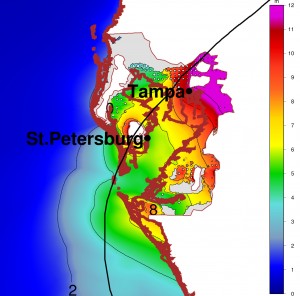By John Sullivan, School of Engineering and Applied Science

Researchers at Princeton and MIT have used computer models to show that severe tropical cyclones could hit a number of coastal cities worldwide that are widely seen as unthreatened by such powerful storms.
The researchers call these potentially devastating storms Gray Swans in comparison with the term Black Swan, which has come to mean truly unpredicted events that have a major impact. Gray Swans are highly unlikely, the researchers said, but they can be predicted with a degree of confidence.
“We are considering extreme cases,” said Ning Lin, an assistant professor of civil and environmental engineering at Princeton. “These are relevant for policy making and planning, especially for critical infrastructure and nuclear power plants.”
In an article published Aug. 31 in Nature Climate Change, Lin and her coauthor Kerry Emanuel, a professor of atmospheric science at the Massachusetts Institute of Technology, examined potential storm hazards for three cities: Tampa, Fla.; Cairns, Australia; and Dubai, United Arab Emirates.
The researchers concluded that powerful storms could generate dangerous storm surge waters in all three cities. They estimated the levels of devastating storm surges occurring in these cities with odds of 1 in 10,000 in an average year, under current climate conditions.
Tampa Bay, for example, has experienced very few extremely damaging hurricanes in its history, the researchers said. The city, which lies on the central-west coast of Florida, was hit by major hurricanes in 1848 and in 1921.
The researchers entered Tampa Bay area climate data recorded between 1980 and 2005 into their model and ran 7,000 simulated hurricanes in the area. They concluded that, although unlikely, a Gray Swan storm could bring surges of up to roughly six meters (18 feet) to the Tampa Bay area. That level of storm surge could dwarf those of the storms of 1848 and 1921, which reached about 4.6 meters and 3.5 meters respectively.
The researchers said their model also indicates that the probability of such storms will increase as the climate changes.
“With climate change, these probabilities can increase significantly over the 21st century,” the researchers said. In Tampa, the current storm surge likelihood of 1 in 10,000 is projected to increase to between 1 in 3,000 and 1 in 1,100 by mid-century and between 1 in 2,500 and 1 in 700 by the end of the century.
The work was supported in part by Princeton’s Project X Fund, the Andlinger Center for Energy and the Environment’s Innovation Fund, and the National Science Foundation.
Ning Lin & Kerry Emanuel, “Grey swan tropical cyclones,” Nature Climate Change (2015); doi:10.1038/nclimate2777

You must be logged in to post a comment.